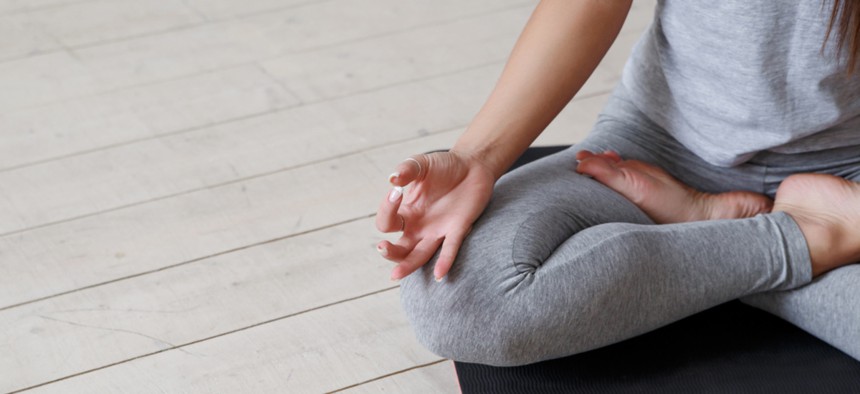Yoga Poses You Can Do at Work for Your Neck, Shoulders, and Upper Back

Evgeny Glazunov/Shutterstock.com
Your muscles are stiff and achey from hunching over a keyboard.
As you read this, take note of your posture. Right now. If your habits are like that of most Quartz readers, you’re reading this on your phone, with your head bent down and your neck tilted forward. Chances are high that your shoulder blades are distancing themselves from your spine, like two teenagers afraid to be seen next to mom.
Many of us assume this posture several times a day, attending to our work and social lives, by turns gripping our phones fiercely, lest we drop them on the street, or reading and texting on them furiously as we stay connected with the world.
While the public appetite for essays reflecting on what all this phone time means to our relationships and social lives has been exhausted (because really, what can we do but adapt?), far fewer words have been dedicated to what it has done to our skeletal architecture, and specifically the health and strength of our necks and upper spines.
“When you look around, you can see that most people have the back of their head lined up vertically in front of their body,” says Steve August, a chiropractor in New Zealand. He calls this posture the “iHunch,” and explains that the spine will lock in that position, in what is traditionally called a dowager’s hump, unless a person takes steps to undo the curve. Hunches used to be associated almost entirely with the elderly. These days, he says, the iHunch is an epic problem— even school children who come to see him are developing the problem.
“There are enough indications now to say that upper back pain may soon eclipse lower back pain as the most common spinal complaint in the developed, computer-savvy world,” he tells Quartz At Work.
The mechanics of the body help explain the problem. A person’s head might weigh 12 lbs. (5.4 kg) when it sits in a neutral, upright position. With every degree that the head is tilted forward, however, it becomes relatively heavier: at a 45-degree angle, gravity makes that 12-pound ball feel like a 48-lb. (22 kg) anchor. Such strain compresses every joint in the neck, and can bring on headaches and stiffness, pinched nerves, and shooting pain in the arms and neck.
Poor posture also effects your mood and ability to think, just as your mood and health can influence your posture. We know, for instance, that taking the physical stance associated with sadness and insecurity can introduce the corresponding mental states.
Slouching also makes you less assertive, psychologist Ann Cuddy suggested in a New York Times op-ed on the effects of phone use on one’s posture. Ironically, as she points out, our palm-sized computers that allow us to work from anywhere bend us into a shape that might actually make a person less productive.
Fortunately, within a few years, technology may change enough that our phone’s screen will be replaced or supplemented by a projected display or augmented reality, eliminating much of the caving in we currently need to do to use a smartphone or laptop.
Until that time, August suggests taking a multi-modal approach to correct the problem. Your intervention might include strengthening exercises and massage, or self-treatment with a prop like a foam roller or his backpod.
Deborah Wolk, a yoga teacher in New York whose studio, Samamkaya Yoga Back Care & Scoliosis Collective, specializes in yoga for back pain and crooked spines, believes people can correct a bent upper spine through a consistent yoga practice, when they’re working with the right teacher and depending on their individual situation.
She recommends limiting the amount of time you remain in one position, whether reading on a phone or a book (remember those?), or typing on a computer. No position is inherently bad for you, she explains. The problems begin when we hang out in one unnatural position for too long.
In our video above, Wolk demonstrates some easy yoga poses that can stretch and release the upper back, neck, shoulders, and an overworked iPhone thumb. All can be done at home, or at work, using props you probably already have lying around. She incorporates an Amazon shipping box in lieu of a yoga block, for instance, and the edges of a doorway frame in lieu of the yoga ropes commonly found in Iyengar yoga classes.
The poses are sequenced by intensity, so you could try them as a series, and even end with a corpse pose (savasana), or you might pick and choose from the poses on an à la carte basis.
Now, please, if you haven’t already, return your head to its upright and balanced position.


